
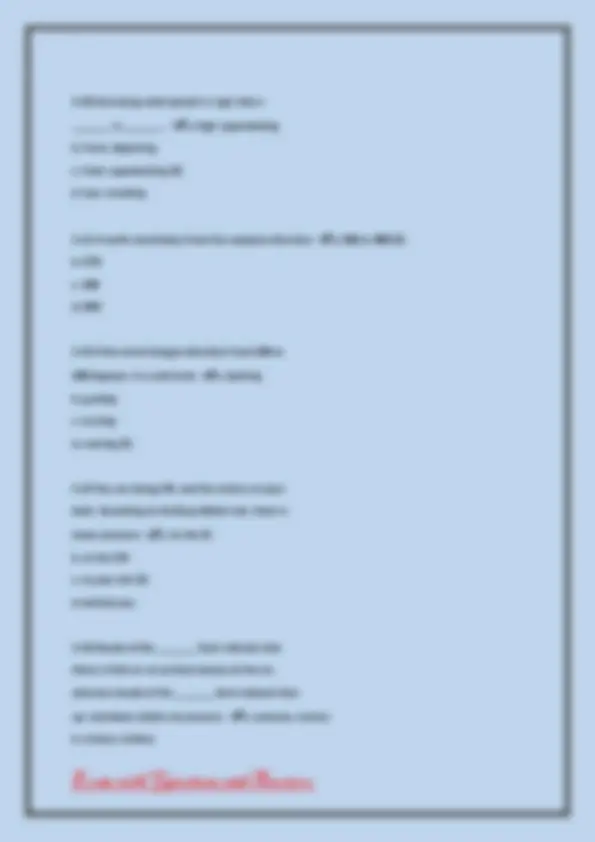
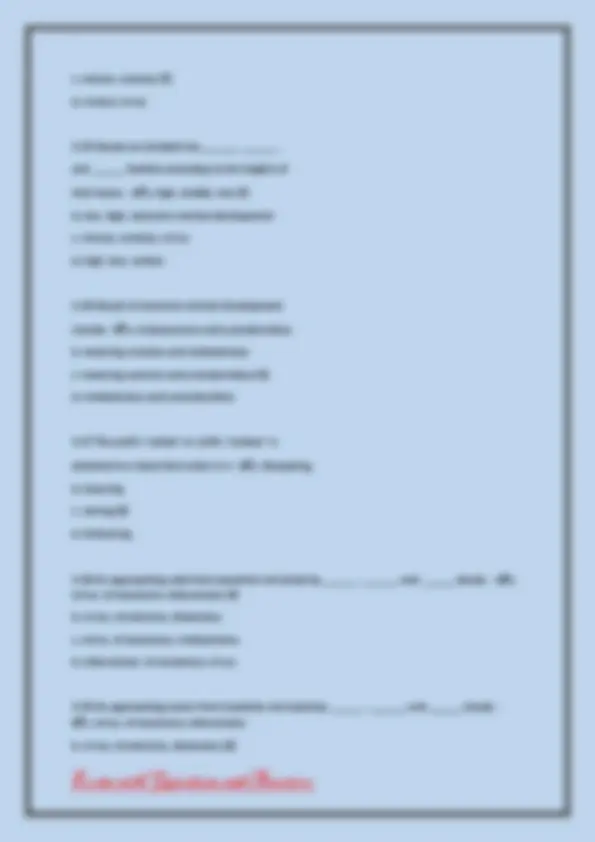
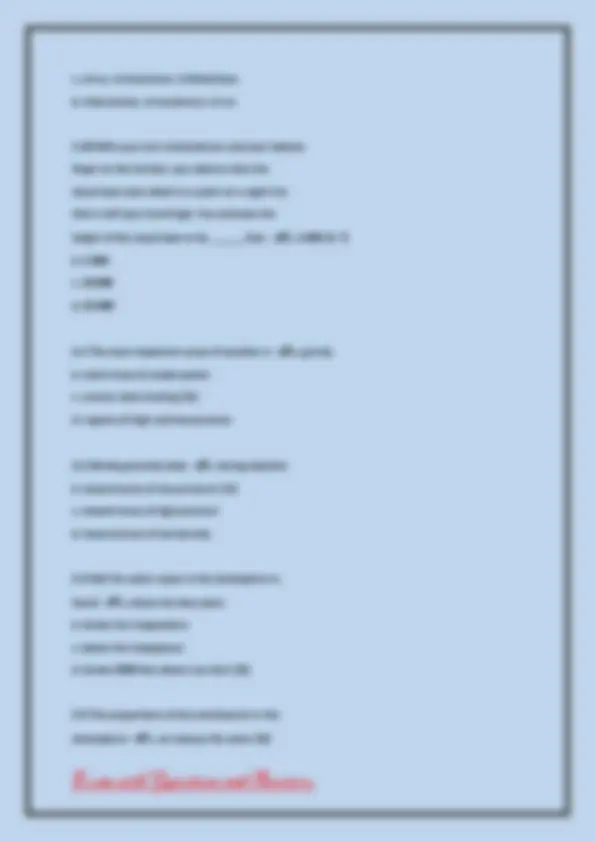
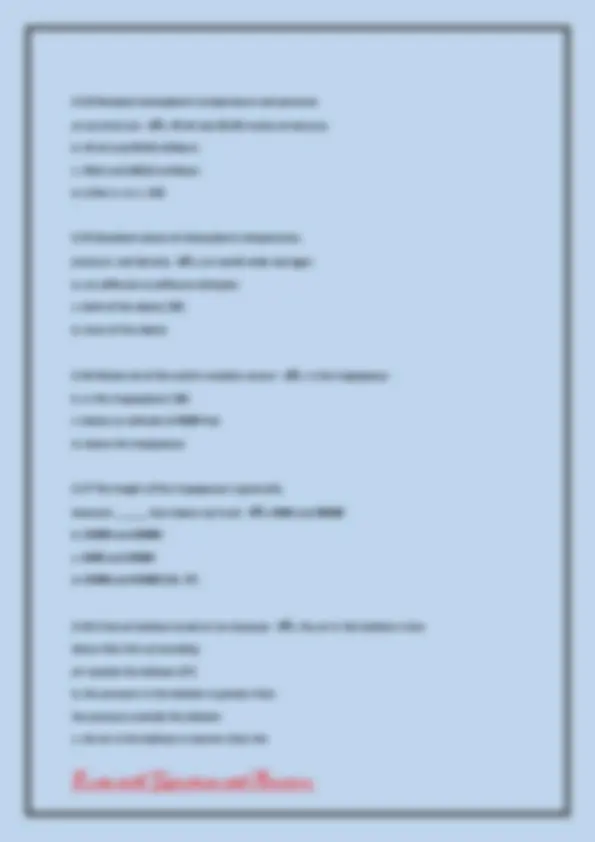
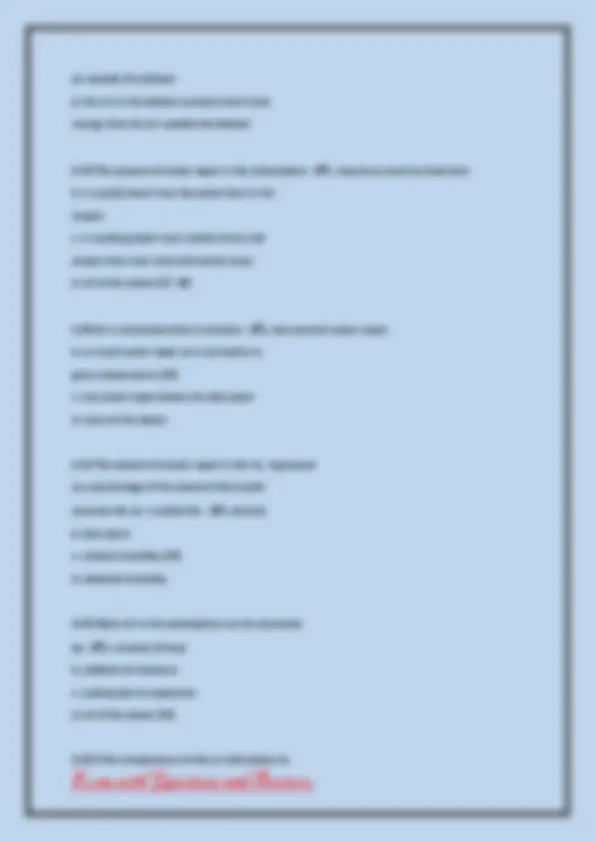
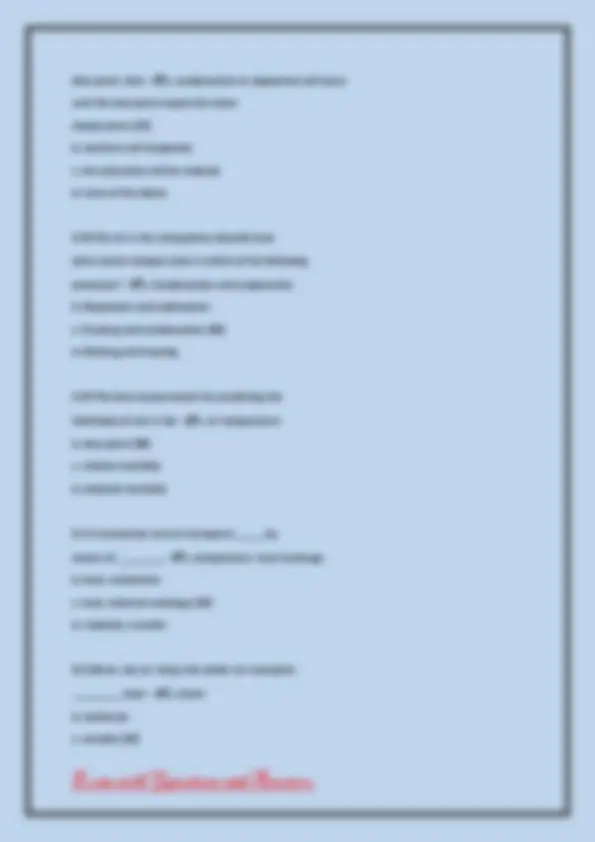
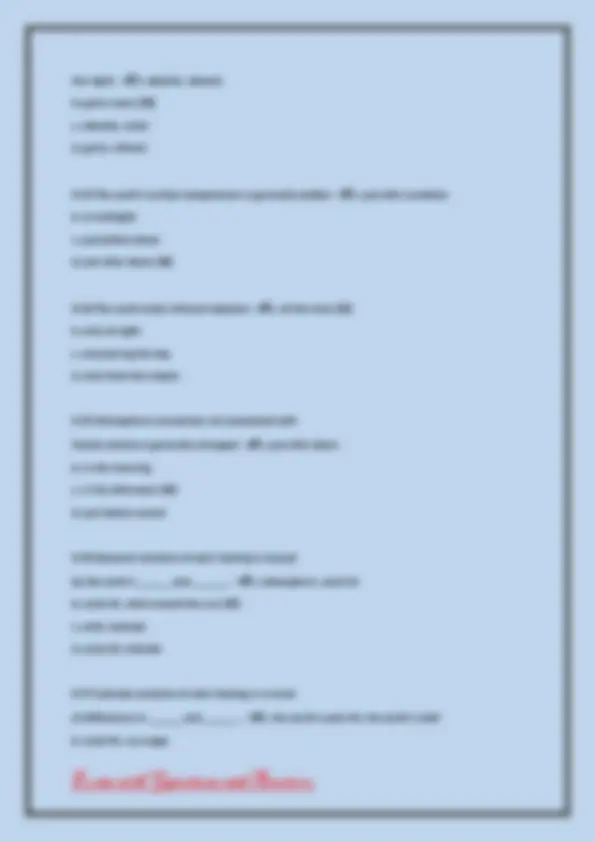
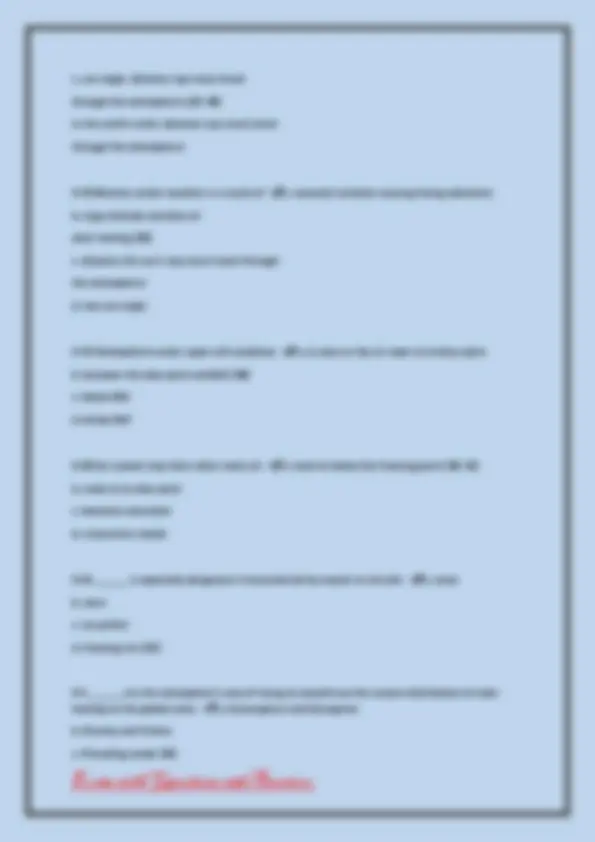
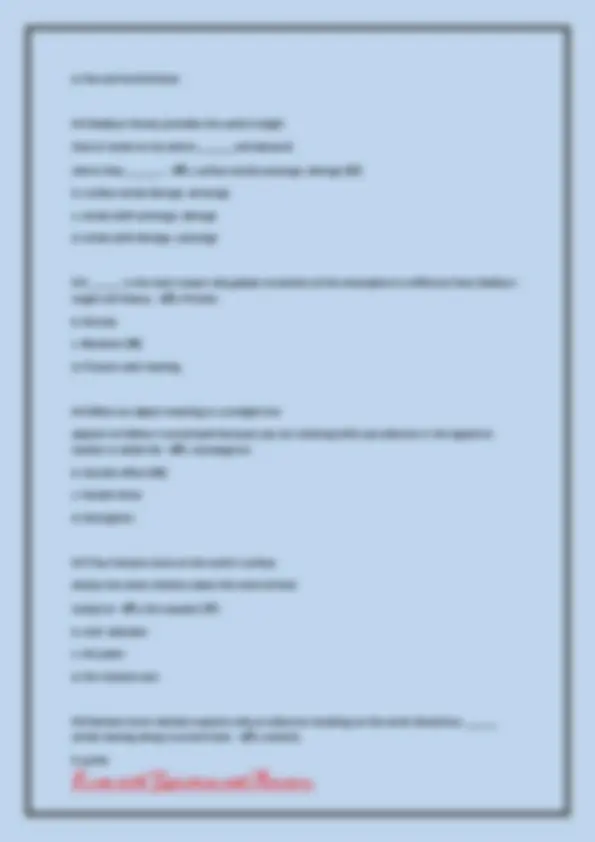
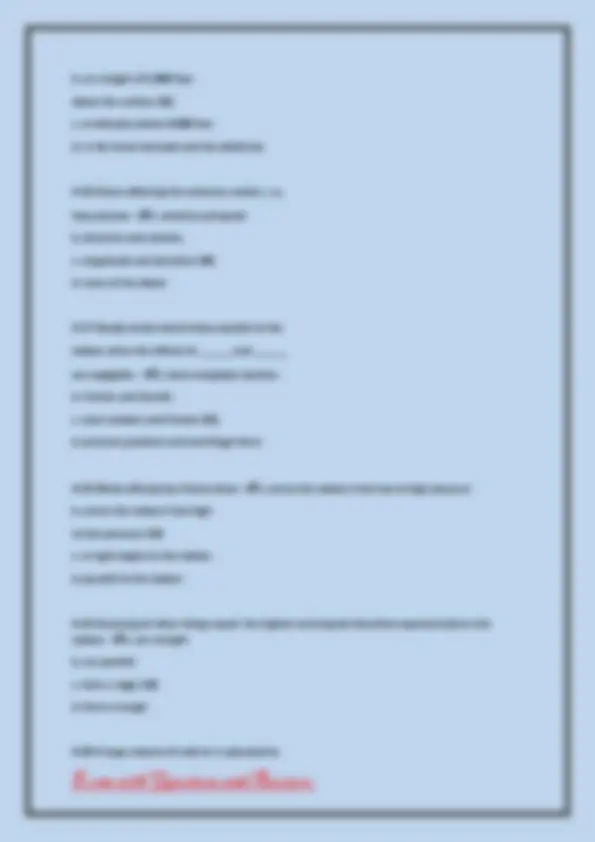
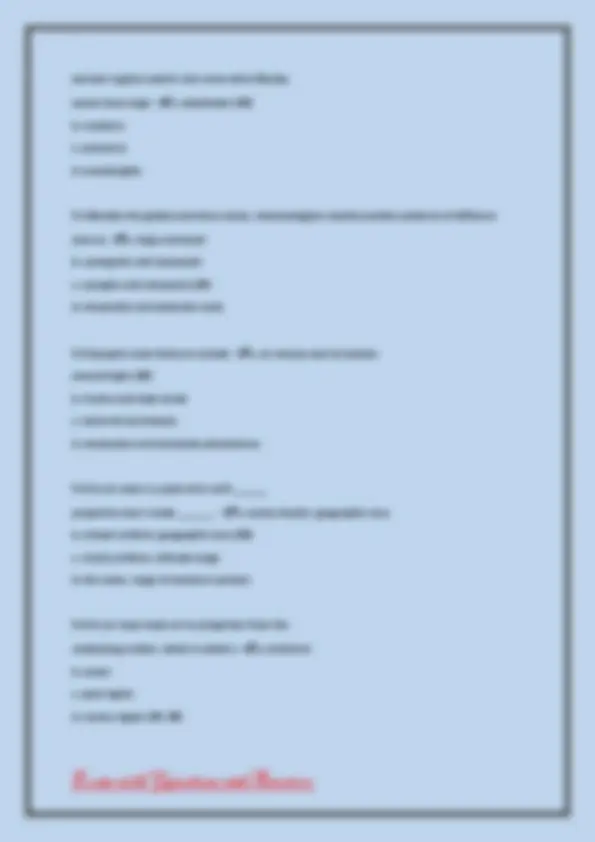
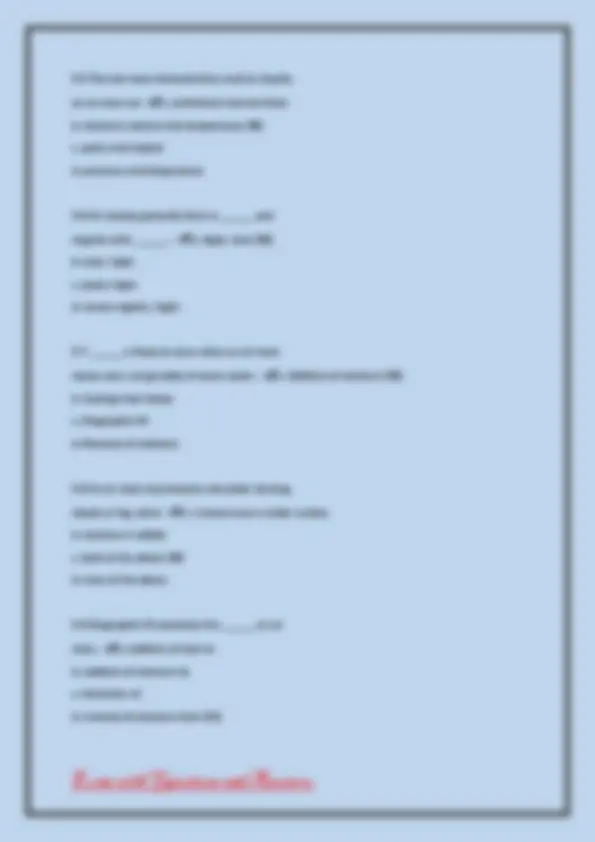
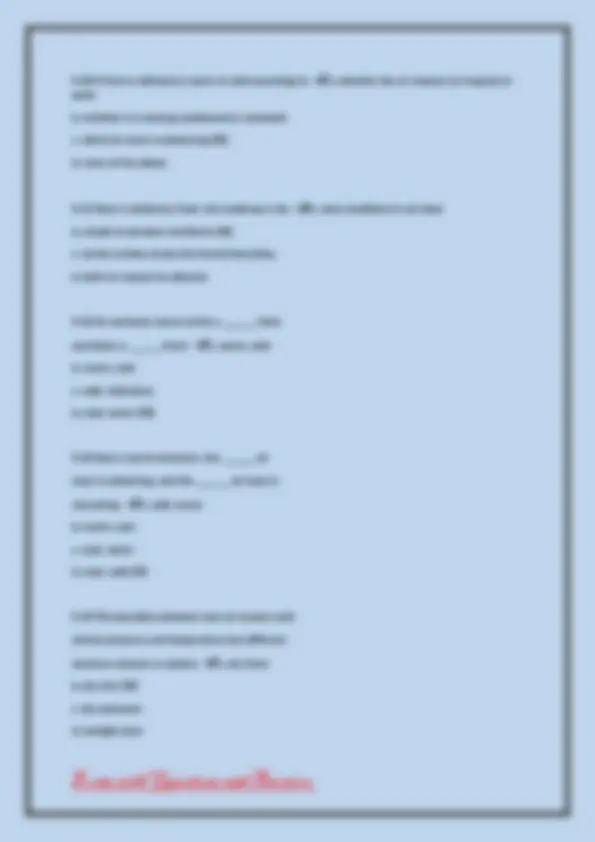
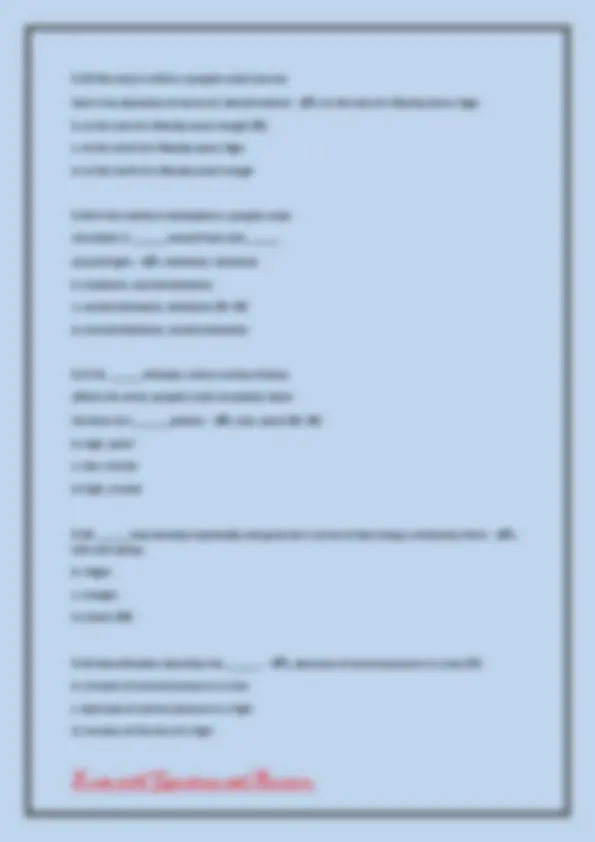
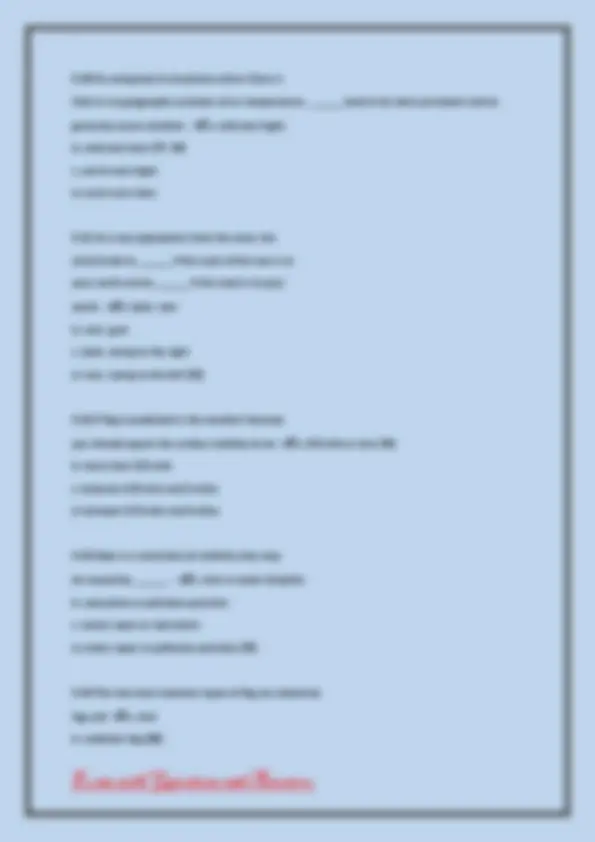
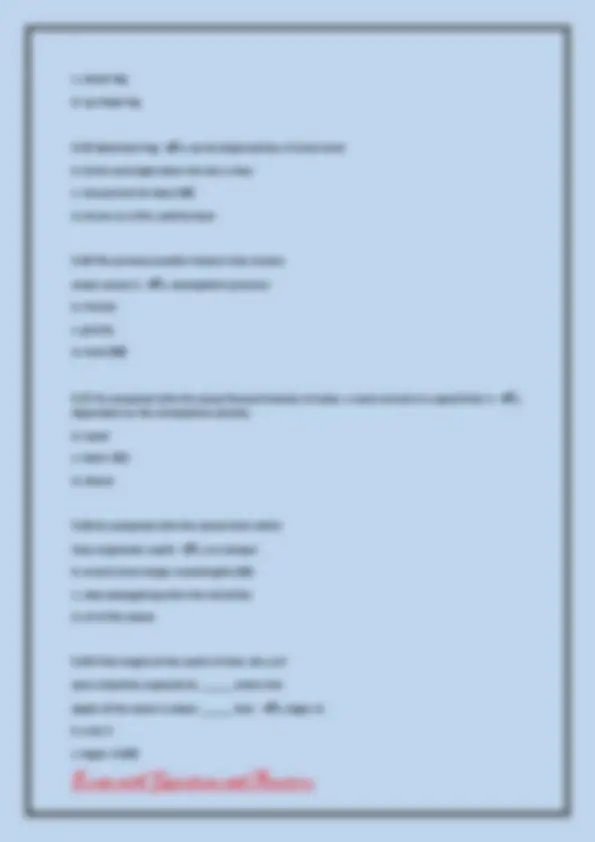
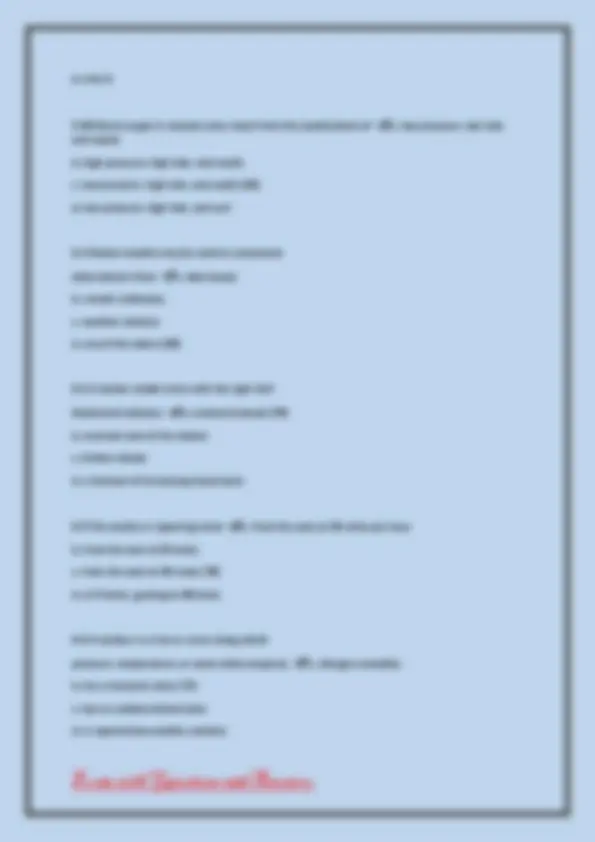
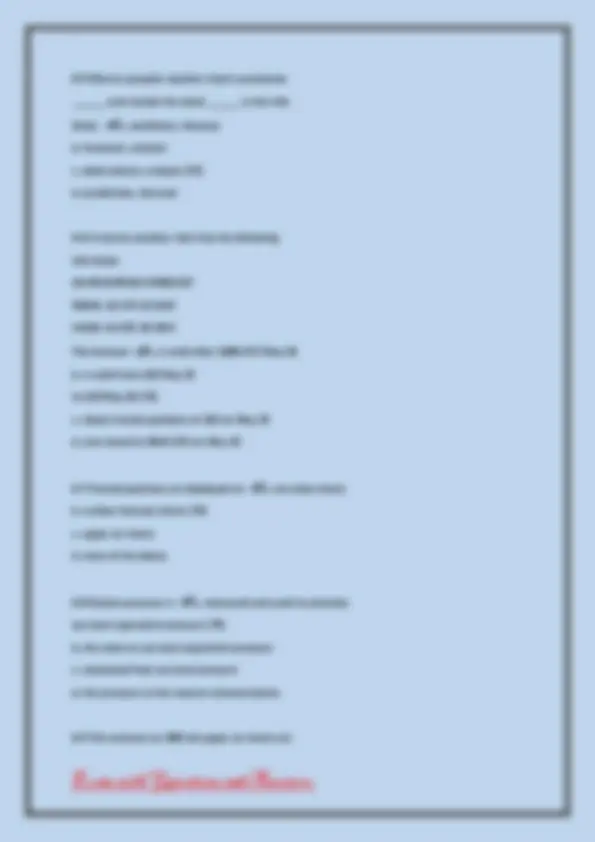
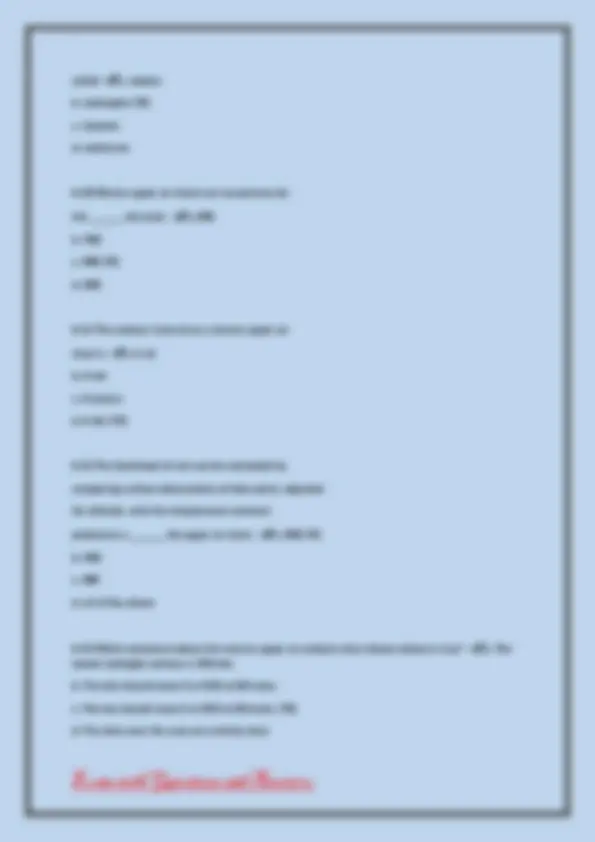
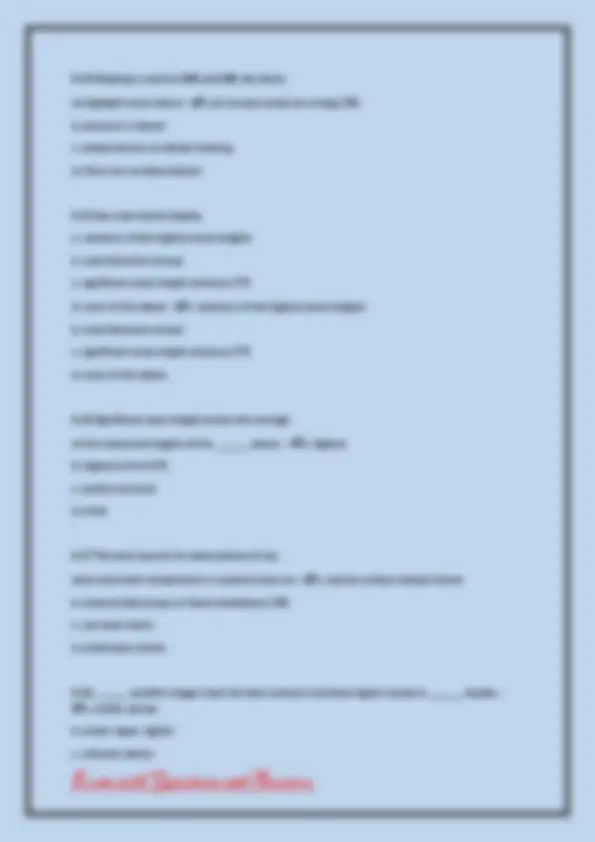
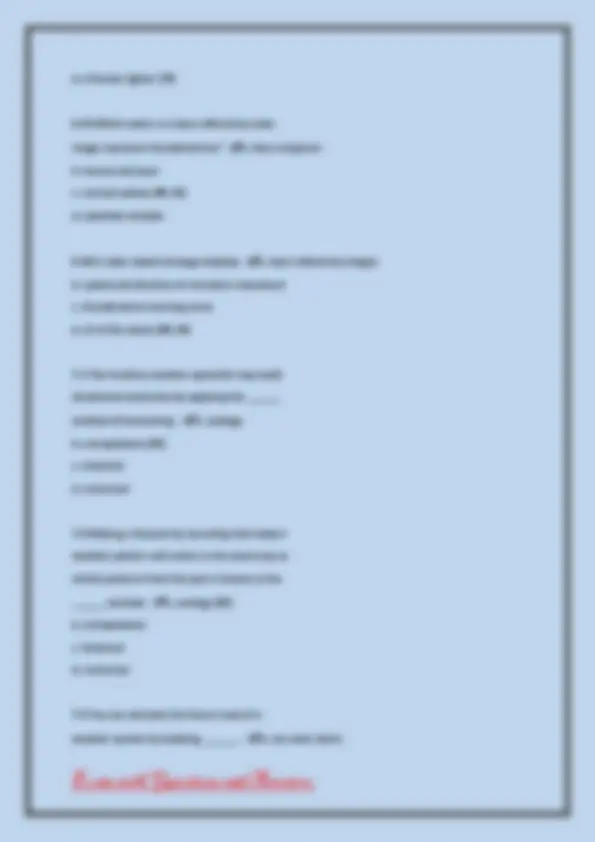
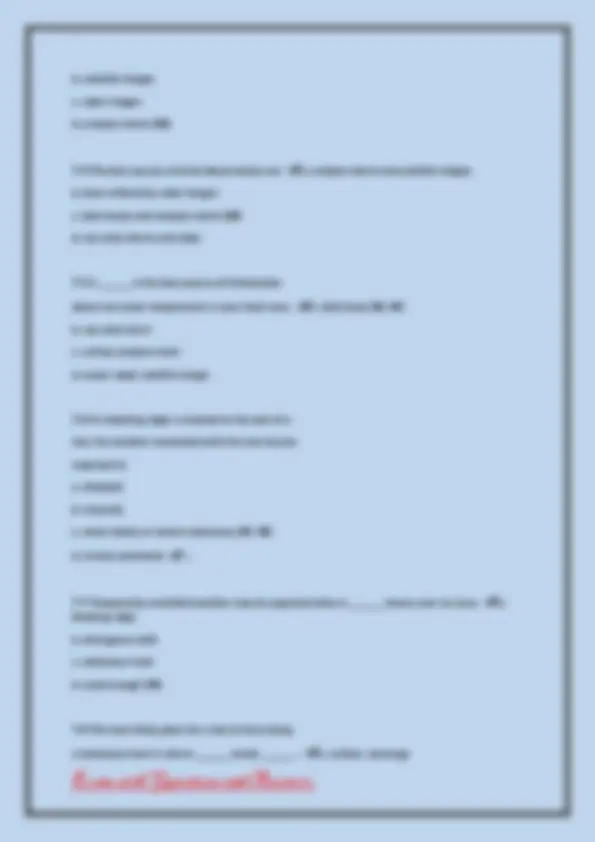
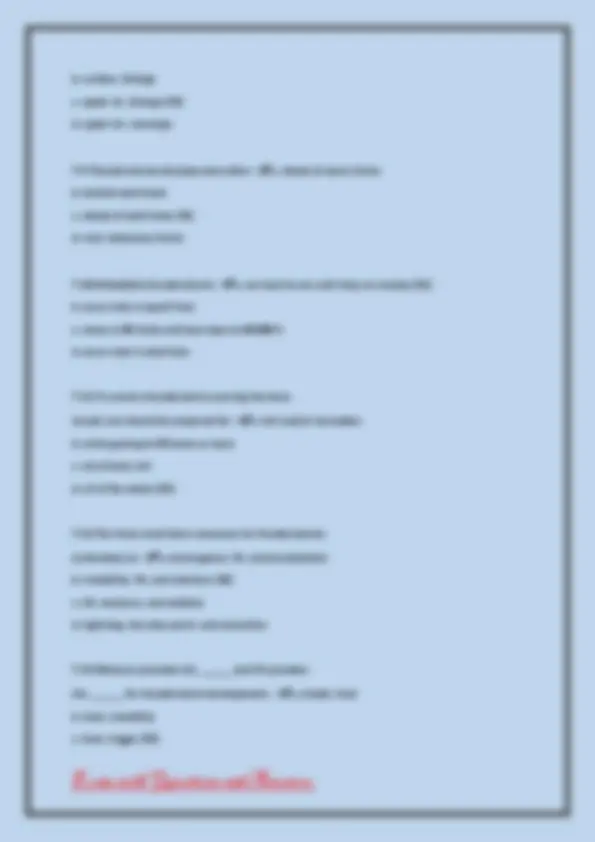
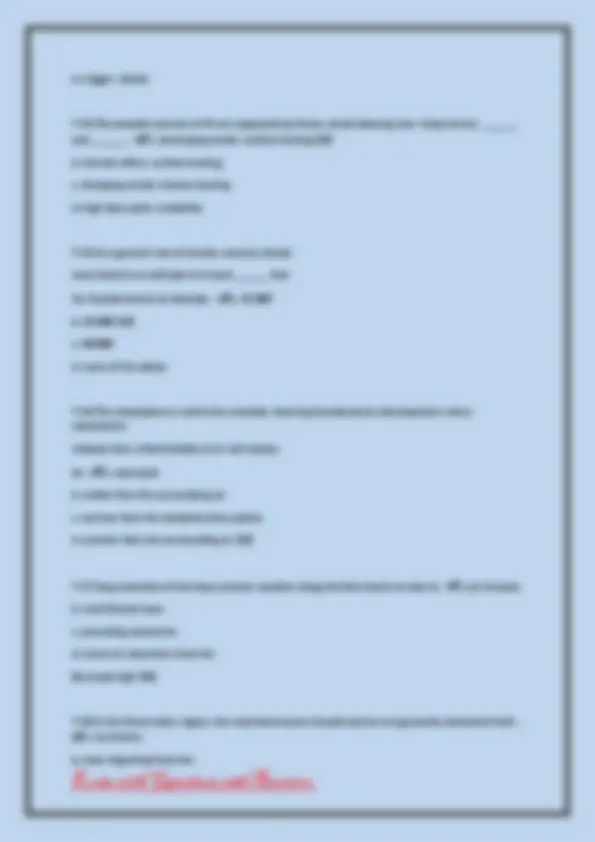
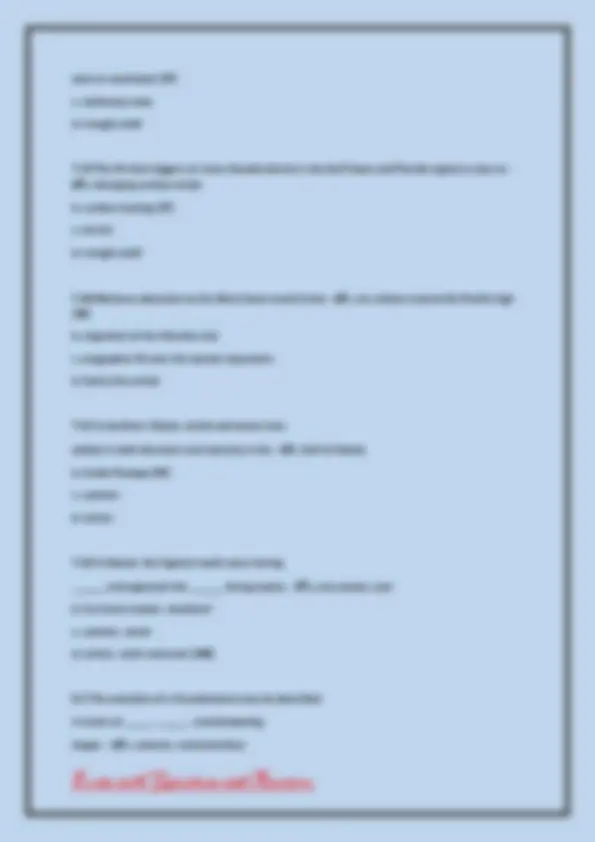
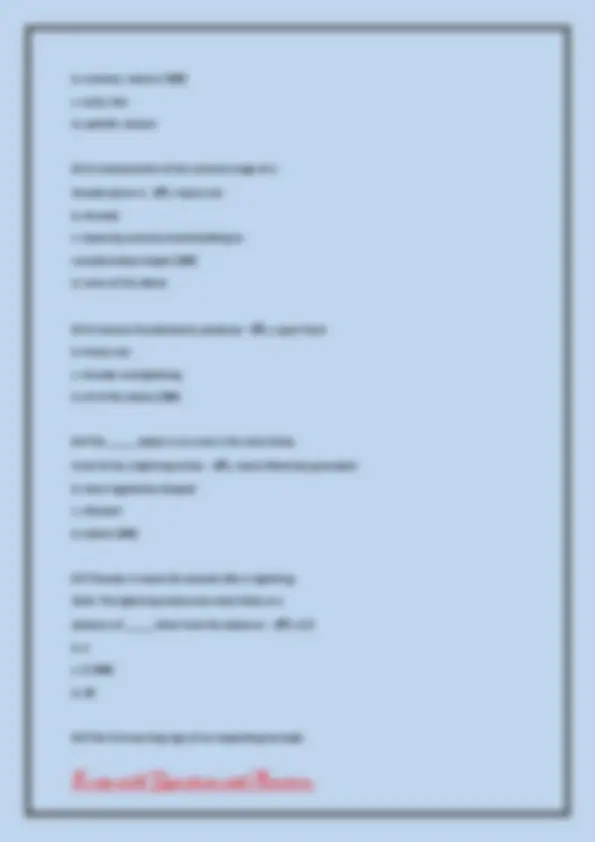
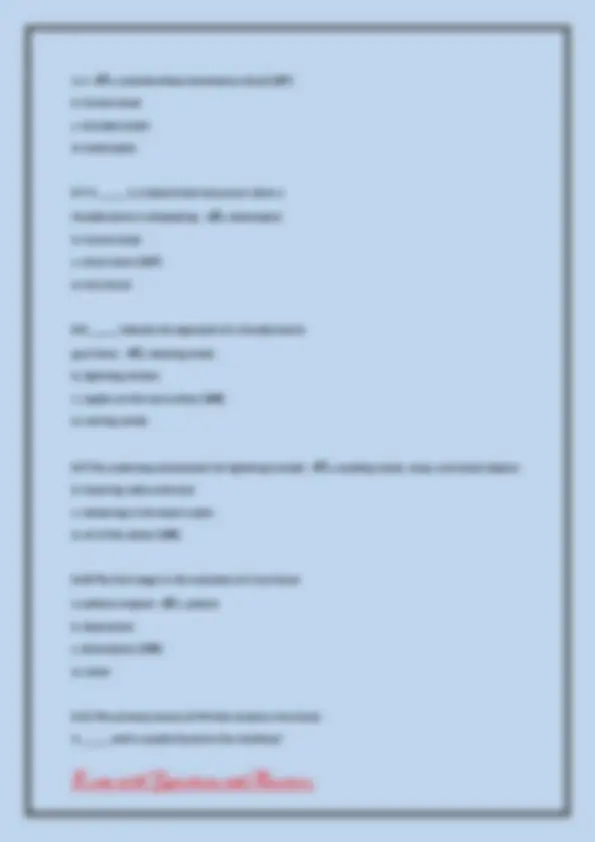
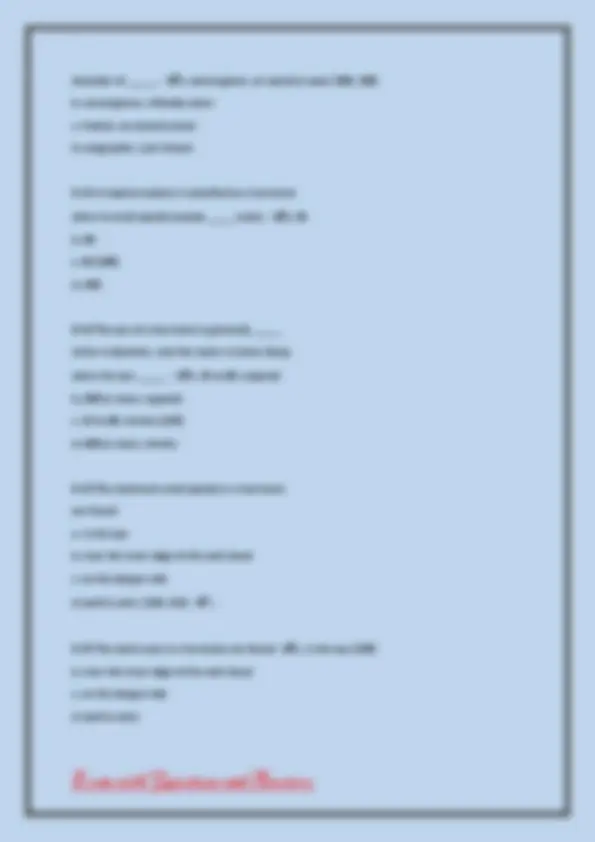
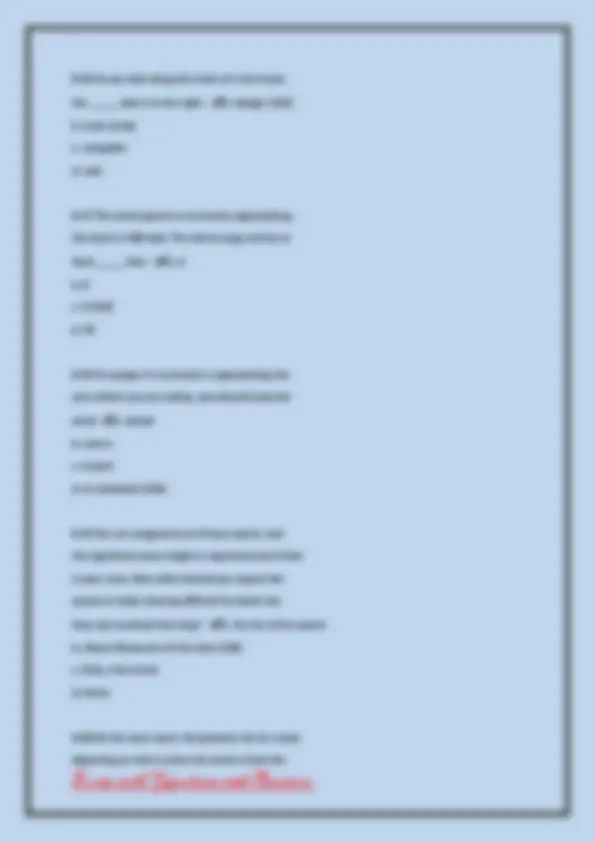
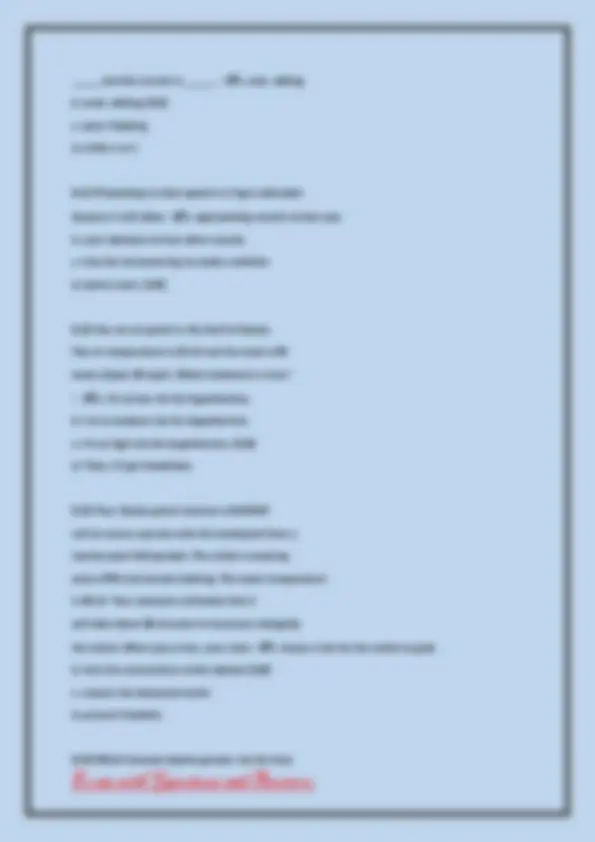



Study with the several resources on Docsity

Earn points by helping other students or get them with a premium plan


Prepare for your exams
Study with the several resources on Docsity

Earn points to download
Earn points by helping other students or get them with a premium plan
Community
Ask the community for help and clear up your study doubts
Discover the best universities in your country according to Docsity users
Free resources
Download our free guides on studying techniques, anxiety management strategies, and thesis advice from Docsity tutors
A comprehensive set of multiple-choice questions and answers covering various aspects of weather and atmospheric science, including weather maps, fronts, humidity, wind, clouds, atmospheric pressure, temperature, and density. It provides a valuable resource for students preparing for the uscg auxiliary auxwea edxam 2025.
Typology: Exams
1 / 39

This page cannot be seen from the preview
Don't miss anything!
































1-1 On a weather map, cold fronts are ind icated
by ________ symbols and warm fronts by
_______ symbols. - ✅a. dark, light
b. triangle, semicircle [2]
c. circle, triangle
d. semicircle, triangle
1-2 To represent a warm or cold front on a
weather map, the appropriate symbol is drawn on
the side toward which - ✅a. the wind is blowing
b. the center of low pressure is located
c. the front is moving [2]
d. the air is colder
1-3 If triangles and semicircles are shown on opposite
sides of the same frontal boundary, the
front is - ✅a. cold
b. occluded
c. stationary [2]
d. warm
1-4 Near a cold front, ______ air is advancing
and replacing the ______ air on the other side. - ✅a. cold, warm [2]
b. cloudy, clear
c. moist, dry
d. windy, calm
1-5 The approach of deteriorating weather is indicated
by a - ✅a. falling hygrometer
b. rising barometer
c. falling barometer [3]
d. falling speedometer
1-6 For best results, an outdoor thermometer
should be - ✅a. bought from a hardware store
b. mounted in a shady spot [3]
c. filled with colored water
d. read on cloudy days
1-7 Humidity is measured by an instrument
called a/an - ✅a. atomizer
b. humidifier
c. hygrometer [4]
d. moisturizer
1-8 The amount of moisture actually in the air, as
a _______ of what the air could contain, is called
the _______ humidity. - ✅a. ratio, measured
b. percentage, relative [4]
c. fraction, atmospheric
d. percentage, partial
1-9 The maximum amount of moisture air can
contain _______ as the air temperature ______. - ✅a. decreases, decreases [4]
b. increases, decreases
c. decreases, increases
d. stays the same, increases
c. stratus, cumulus [5]
d. stratus, cirrus
1-15 Clouds are divided into ______ , ______ ,
and ______ families according to the heights of
their bases. - ✅a. high, middle, low [5]
b. low, high, extensive vertical development
c. stratus, cumulus, cirrus
d. high, low, surface
1-16 Clouds of extensive vertical development
include - ✅a. stratocumulus and cumulonimbus
b. towering cumulus and nimbostratus
c. towering cumulus and cumulonimbus [6]
d. nimbostratus and cumulonimbus
1-17 The prefix "nimbo" or suffix "nimbus" is
attached to a cloud form when it is - ✅a. dissipating
b. lowering
c. raining [6]
d. thickening
1-18 An approaching cold front would be ind icated by ______ , ______, and ______ clouds. - ✅a. cirrus, cirrocumulus, altocumulus [6]
b. cirrus, cirrostratus, altostratus
c. cirrus, cirrocumulus, nimbostratus
d. altocumulus, cirrocumulus, cirrus
1-19 An approaching warm front would be ind icated by ______ , ______, and ______ clouds. - ✅a. cirrus, cirrocumulus, altocumulus
b. cirrus, cirrostratus, altostratus [6]
c. cirrus, cirrocumulus, nimbostratus
d. altocumulus, cirrocumulus, cirrus
1-20 With your arm stretched out and your bottom
finger on the horizon, you observe that the
cloud base loses detail at a point on a sight line
that is half your hand high. You estimate the
height of the cloud base to be ______ feet. - ✅a. 2,500 [6, 7]
b. 5,
c. 10,
d. 25,
2-1 The most important cause of weather is - ✅a. gravity
b. latent heat of condensation
c. uneven solar heating [11]
d. regions of high and low pressure
2-2 Winds generally blow - ✅a. during daytime
b. toward areas of low pressure [11]
c. toward areas of high pressure
d. toward areas of low density
2-3 Half the water vapor in the atmosphere is
found - ✅a. above the dew point
b. below the troposphere
c. below the tropopause
d. below 6500 feet above sea level [12]
2-4 The proportions of dry constituents in the
atmosphere - ✅a. are always the same [12]
d. absolute temperature and humidity
2-10 Which is heavier, a pound of air or a pound
of iron? - ✅a. The air
b. The iron
c. Neither, they have the same density
d. Neither, but the iron is more dense [13]
2-11 An Auxiliarist weighing 150 pounds stands
on a scale with an area of half a square foot. A
weight of 300 pounds sits on a piece of plywood
with an area of one square foot. - ✅a. The pressure on the scale is less than the
pressure on the plywood.
b. The pressure on the scale is the same as
the pressure on the plywood. [14]
c. The pressure on the scale is more than the
pressure on the plywood.
d. There is more weight on the scale.
2-12 When air is free to expand, its temperature
may be changed by - ✅a. changing its volume
b. adding heat energy
c. removing heat energy
d. all of the above [14, 15]
2-13 If the volume of some air increases by ten
percent, but the temperature of the air remains
constant, the air pressure will - ✅a. decrease by ten percent [15]
b. increase by ten percent
c. not change
d. be proportional to the volume
2-14 Standard atmospheric temperature and pressure
at sea level are - ✅a. 59 oF and 29.92 inches of mercury
b. 15 oC and 29.92 millibars
c. 15oC and 1013.2 millibars
d. either a. or c. [16]
2-15 Standard values of atmospheric temperature,
pressure, and density - ✅a. are world wide averages
b. are different at different altitudes
c. both of the above [16]
d. none of the above
2-16 Almost all of the earth's weather occurs - ✅a. in the tropopause
b. in the troposphere [16]
c. below an altitude of 6500 feet
d. above the tropopause
2-17 The height of the tropopause is generally
between ______ feet above sea level - ✅a. 6500 and 30000
b. 25000 and 30000
c. 6500 and 65000
d. 25000 and 65000 [16, 17]
2-18 A hot air balloon tends to rise because - ✅a. the air in the balloon is less
dense than the surrounding
air outside the balloon [17]
b. the pressure in the balloon is greater than
the pressure outside the balloon
c. the air in the balloon is warmer than the
dew point, then - ✅a. condensation or deposition will occur
until the dew point equals the lower
temperature [19]
b. moisture will evaporate
c. the saturation will be reduced
d. none of the above
2-24 The air in the atmosphere absorbs heat
when water changes state in which of the following
processes? - ✅a. Condensation and evaporation
b. Deposition and sublimation
c. Freezing and condensation [20]
d. Melting and freezing
2-25 The best measurement for predicting the
likelihood of rain is the - ✅a. air temperature
b. dew point [20]
c. relative humidity
d. absolute humidity
3-1 A convection current transports _____ by
means of ________. - ✅a. temperature, heat exchange
b. heat, conduction
c. heat, material exchange [25]
d. radiation, transfer
3-2 Warm, dry air rising into colder air transports
_________ heat. - ✅a. latent
b. molecular
c. sensible [25]
d. sensitive
3-3 Rising moist air transports both sensible and
_______ heat. - ✅a. advective
b. infrared
c. latent [25]
d. vaporous
3-4 A wind blowing warm air from the south toward
colder air to the north is transporting heat by
means of - ✅a. advection [25, 26]
b. conduction
c. convection
d. radiation
3-5 When sunshine strikes the earth's surface, a
layer of soil below the surface is warmed by - ✅a. advection
b. conduction [26]
c. convection
d. radiation
3-6 At night, the temperature of a soil layer will
decrease faster than the temperature of an ocean
water layer because - ✅a. there is no solar radiation at night
b. the surfaces emit infrared to the atmosphere
c. the soil heat capacity is greater
d. the soil heat capacity is lower [26]
3-7 Warm land and water surfaces radiate heat to
the atmosphere at ______ wavelengths. - ✅a. infrared [26]
the night. - ✅a. absorbs, advects
b. gains, loses [28]
c. absorbs, emits
d. gains, reflects
3-13 The earth's surface temperature is generally coldest - ✅a. just after sundown
b. at midnight
c. just before dawn
d. just after dawn [28]
3-14 The earth emits infrared radiation - ✅a. all the time [29]
b. only at night
c. only during the day
d. only from the tropics
3-15 Atmospheric convection not associated with
frontal activity is generally strongest - ✅a. just after dawn
b. in the morning
c. in the afternoon [29]
d. just before sunset
3-16 Seasonal variation of solar heating is caused
by the earth's ______ and ______. - ✅a. atmosphere, axial tilt
b. axial tilt, orbit around the sun [29]
c. orbit, latitude
d. axial tilt, latitude
3-17 Latitude variation of solar heating is a result
of differences in ______ and ______. - ✅a. the earth's axial tilt, the earth's orbit
b. axial tilt, sun angle
c. sun angle, distance rays must travel
through the atmosphere [29, 30]
d. the earth's orbit, distance rays must travel
through the atmosphere
3-18 Blustery winter weather is a result of - ✅a. seasonal variation causing strong advection
b. large latitude variation of
solar heating [30]
c. distance the sun's rays must travel through
the atmosphere
d. low sun angle
3-19 Atmospheric water vapor will condense - ✅a. as soon as the air cools to its dew point
b. between the dew point and 0oC [30]
c. below 0oC
d. below 0oF
3-20 Ice crystals may form when moist air - ✅a. cools to below the freezing point [30, 31]
b. cools to its dew point
c. becomes saturated
d. encounters clouds
3-21 ______ is especially dangerous if encountered by vessels or aircraft. - ✅a. snow
b. sleet
c. ice pellets
d. freezing rain [31]
4-1 ______ are the atmosphere's way of trying to smooth out the uneven distribution of solar heating on the global scale. - ✅a. Convergence and divergence
b. Gravity and friction
c. Prevailing winds [35]
c. northerly [37]
b. westerly
4-7 ______ force refers to the force exerted by a
body moving in a circle and is directed ______
from the ______. - ✅a. Centrifugal, inward, body
b. Pressure gradient, outward, center
c. Gravity, inward, earth
d. Centrifugal, outward,
axis of rotation [37, 38]
4-8 ______ winds follow a curved track to the
south in the northern hemisphere due to ______.
a. Easterly, decreased centrifugal force
b. Westerly, increased gravitational force
c. Westerly, increased centrifugal force [38]
d. Westerly, increased pressure gradient - ✅a. Easterly, decreased centrifugal force
b. Westerly, increased gravitational force
c. Westerly, increased centrifugal force [38]
d. Westerly, increased pressure gradient
4-9 The Coriolis effect is strongest at ______ and disappears at ______. - ✅a. the equator, the poles
b. the poles, the equator [37, 38]
c. mid- latitudes, the equator
d. mid- latitudes, the poles
4-10 The ______ and the ______ are semipermanent pressure belt features that have a significant
effect on continental US weather. - ✅a. Aleutian low, Bermuda triangle
b. ITCZ, trade winds
c. Pacific high, Bermuda high [39]
d. Aleutian low, Icelandic low
4-11 The ______ and the ______ are separated
by a belt of light and variable winds called the
______. - ✅a. trade winds, westerlies,
horse latitudes [40]
b. trade winds, westerlies, doldrums
c. trade winds, westerlies, ITCZ
d. NE, SE trade winds, horse latitudes
4-12 The subtropical and polar jet streams are
high-speed "rivers" of air found near - ✅a. latitudes 60S and 60N
b. 30 S and 30 N
c. latitudes 30 and 60 [40]
d. the doldrums and the horse latitudes
4-13 As a general rule, air moving into an area of low pressure tends to ______ , and air moving
into an area of high pressure tends to ______. - ✅a. rise, descend [41]
b. slow down, speed up
c. descend, rise
d. speed up, slow down
4-14 The force of friction on a westerly jet
stream is directed toward the - ✅a. north
b. east
c. south
d. west [42]
4-15 The force of friction on winds in the atmosphere becomes negligible in comparison with
other forces - ✅a. at the surface
warmer regions and/or vice versa when Rossby
waves have large - ✅a. amplitudes [44]
b. numbers
c. pressures
d. wavelengths
5-1 Besides the global and micro scales, meteorologists classify weather patterns of different
sizes as - ✅a. large and small
b. synergistic and mesoscale
c. synoptic and mesoscale [49]
d. mesoscale and molecular scale
5-2 Synoptic scale features include - ✅a. air masses and circulation
around highs [49]
b. fronts and trade winds
c. land and sea breezes
d. mesoscale and microscale phenomena
5-3 An air mass is a pool of air with ______
properties over a wide ______. - ✅a. nearly chaotic, geographic area
b. almost uniform, geographic area [49]
c. nearly uniform, altitude range
d. the same, range of moisture content
5-4 An air mass takes on its properties from the
underlying surface, which is called a - ✅a. continent
b. ocean
c. pool region
d. source region [49, 50]
5-5 The two main characteristics used to classify
an air mass are - ✅a. continental and maritime
b. moisture content and temperature [50]
c. polar and tropical
d. pressure and temperature
5-6 Air masses generally form in ______ and
migrate with ______. - ✅a. highs, lows [50]
b. lows, highs
c. pools, highs
d. source regions, highs
5-7 ______ is likely to occur when an air mass
moves over a large body of warm water. - ✅a. Addition of moisture [50]
b. Cooling from below
c. Orographic lift
d. Removal of moisture
5-8 An air mass may become saturated, forming
clouds or fog, when - ✅a. it moves over a colder surface
b. moisture is added
c. both of the above [50]
d. none of the above
5-9 Orographic lift promotes the ______ an air
mass. - ✅a. addition of heat to
b. addition of moisture to
c. formation of
d. removal of moisture from [51]